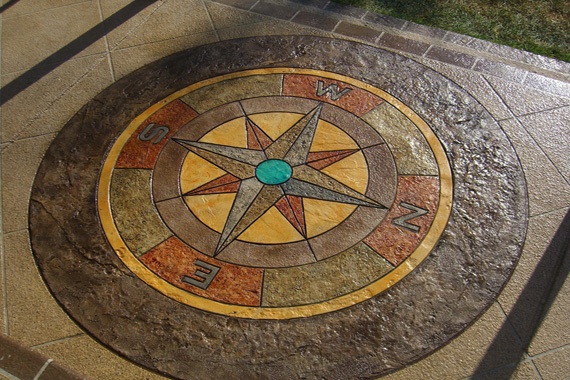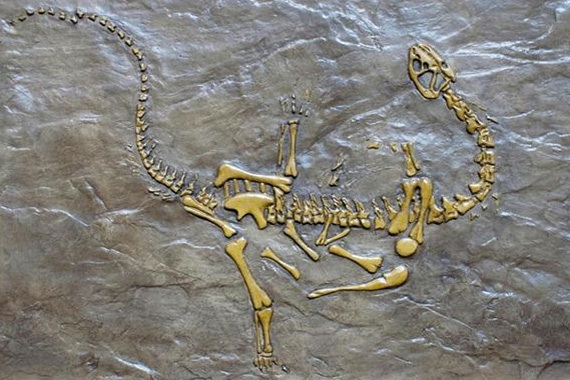 |
Dyed concrete adds some flair to patio designs. Image: Pacific Concrete Images |
A stamped concrete patio gives you the look and texture of a stone patio for a lot less than the real thing — up to 50% less than the cost of natural slate or limestone.
That’s not all. Stamped concrete can mimic brick, cobblestones, cracked earth, and weathered wood. Add a bit of fun with leaf patterns, animal shapes, even dinosaur footprints.
Best of all, a stamped concrete patio is low-maintenance — the “stones” won’t settle over time, creating uneven surfaces, and there are no grout or joints that can open up to let grass and weeds sprout.
What’s a Stamped Concrete Patio?
 |
Concrete stamping requires specialty tools to shape and smooth the surface properly. Image: Enjoying the Scenery |
A stamped concrete patio is simply a concrete slab with a textured, embossed surface. The contractor:
- Pours and smooths the slab.
- Presses a pattern into the surface while the concrete is still wet and soft.
- For realism, adds color to the concrete as it’s mixed, or sprays it on after the surface has been stamped.
- Make sure you hire a contractor who’s done stamping, and has the examples to prove it. Check references.
What’s the Deal with the Stamps?
 |
| This stamped concrete patio has a hand-tooled border. Image: The Concrete Artisans, Inc. |
The patterns are made using large, flexible polyurethane stamps. The stamps are about 2-by-2-feet square and an inch or two thick, and they’re pressed into the wet concrete to create the textured finish.
A concrete contractor may step on the stamps to press them into the concrete or use a tamping tool. Before putting the stamp on the concrete, the contractor sprays the patterned side of the stamp with a release agent that prevents concrete from sticking to it.
Using a colored release agent accents cracks and grout lines, giving the finish an “antique” look that enhances realism.
One pattern usually is a set that includes several stamps, each one with varying textures and shapes, so the overall pattern isn’t repeated too frequently. Stamps also have interlocking tabs so any grout lines align perfectly.
What’s It Cost?
 |
| Unique imprints, such as these dinosaur fossils, make a stamped concrete patio design your own. Image: Table Mountain Creative Concrete, Golden, CO |
A stamped concrete patio costs $10-$15 per square foot, professionally installed. Here’s a quick price comparison:
- Plain concrete: $6-$12 per sq. ft.
- Brick: $14-$20 per sq. ft.
- Stone, slate, or marble: $17-$28 per sq. ft.
- Concrete pavers: $13-$20 per sq. ft.
Can I Do It Myself?
Making a stamped concrete patio is a fairly simple process, but only skilled DIYers should attempt it. That’s because concrete can be a tricky medium to work with:
- It requires a properly installed base of compacted sand and gravel.
- It’s heavy; you’ll need to be strong.
- Concrete requires specialty tools to shape and smooth the surface (any specialty tool performs best in the hands of an experienced worker who knows how to use it).
- Concrete sets up relatively quickly. Once it starts to harden, it’s difficult to apply the stamps.
- A mistake in concrete is permanent.
Any Drawbacks to a Stamped Concrete Patio?
Very few:
- Deep depressions. Although stamped concrete is a good choice for ADA accessibility, be wary of deeply embossed patterns; all that texture may be tempting, but it creates uneven surfaces that make patio furniture wobble and may be hazardous for those with limited mobility. Accessibility guidelines require bumps and ridges on walking surfaces be no more than ¼-inch high.
- Fair-weather color. Although you’ll have more color options with surface colorants, the colorants may flake off over time. Have your concrete dyed while it’s being mixed for a more permanent solution.
- It’s got a ‘tell’. As good as stamped concrete may look, aficionados of real brick and stone will know the difference.
Can I Add a Stamped Finish to an Existing Patio Slab?
Yes you can, as long as your old slab is stable and in good condition. You’ll be raising the height of the old slab by an inch or so, so you’ll want to make sure the new level doesn’t interfere with existing steps or vents in your foundation walls. The new concrete shouldn’t touch your siding, either.
A pro will prepare the existing slab by cleaning it and covering it with a bonding agent that ensures good adhesion between the old concrete and the new.
Then, your contractor will cover the old slab with new concrete, and apply the stamps.
Source: Houselogic.com

4 comments:
Stamped concrete truly does allow for that "unique" personal design. Really like the design for the patio in the beginning of the blog. Thank you for sharing.
Patios Pools Driveways Inc
Also, the dinosaur fossil is truly an amazing look. I have never seen that before in stamped concrete. Thank you for sharing.
Patios Pools Driveways Inc
You have a good point here!I totally agree with what you have said!!Thanks for sharing your views...hope more people will read this article!!! Concrete repair Nanaimo
This is very educational content and written well for a change. It's nice to see that some people still understand how to write a quality post! concrete houston
Post a Comment